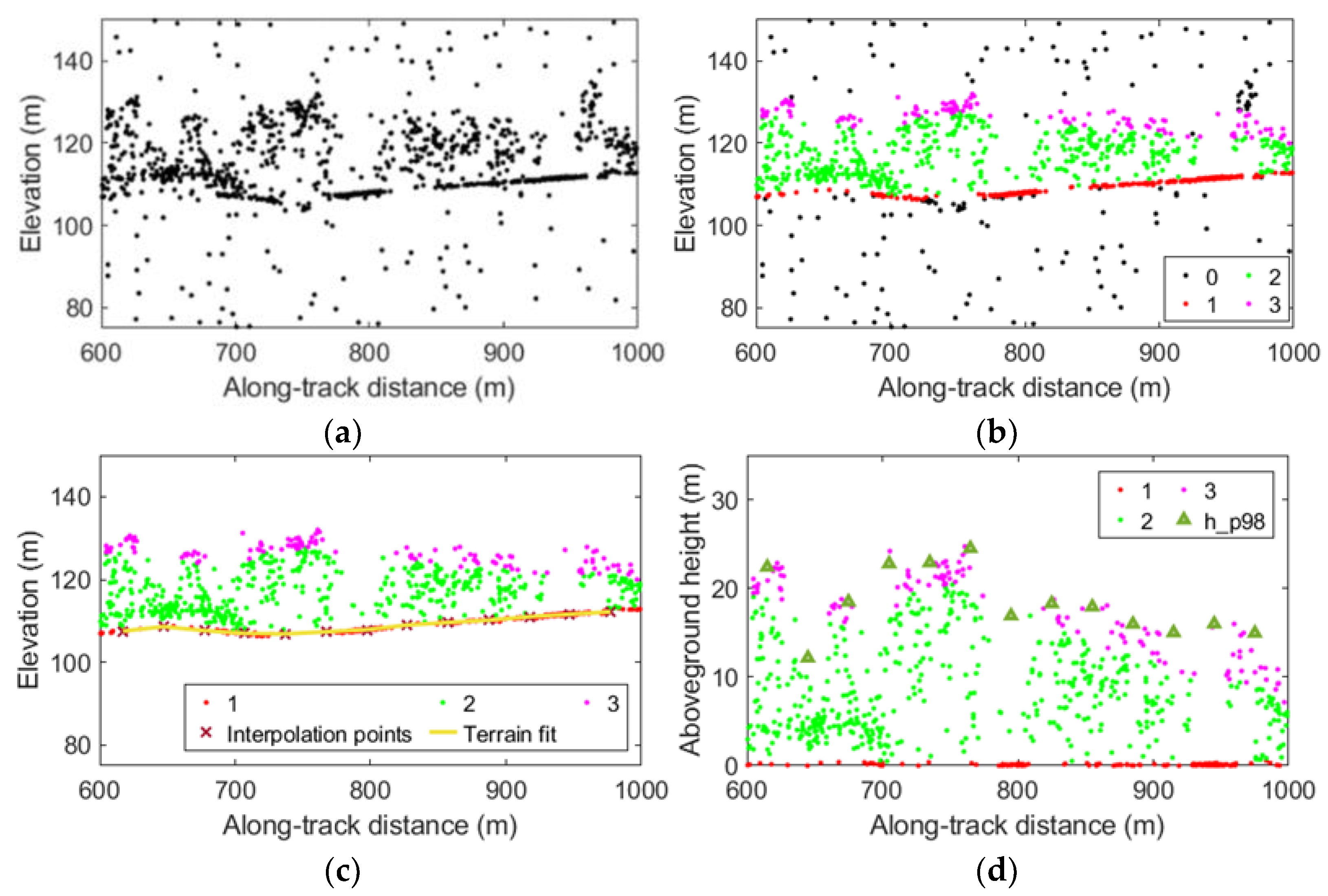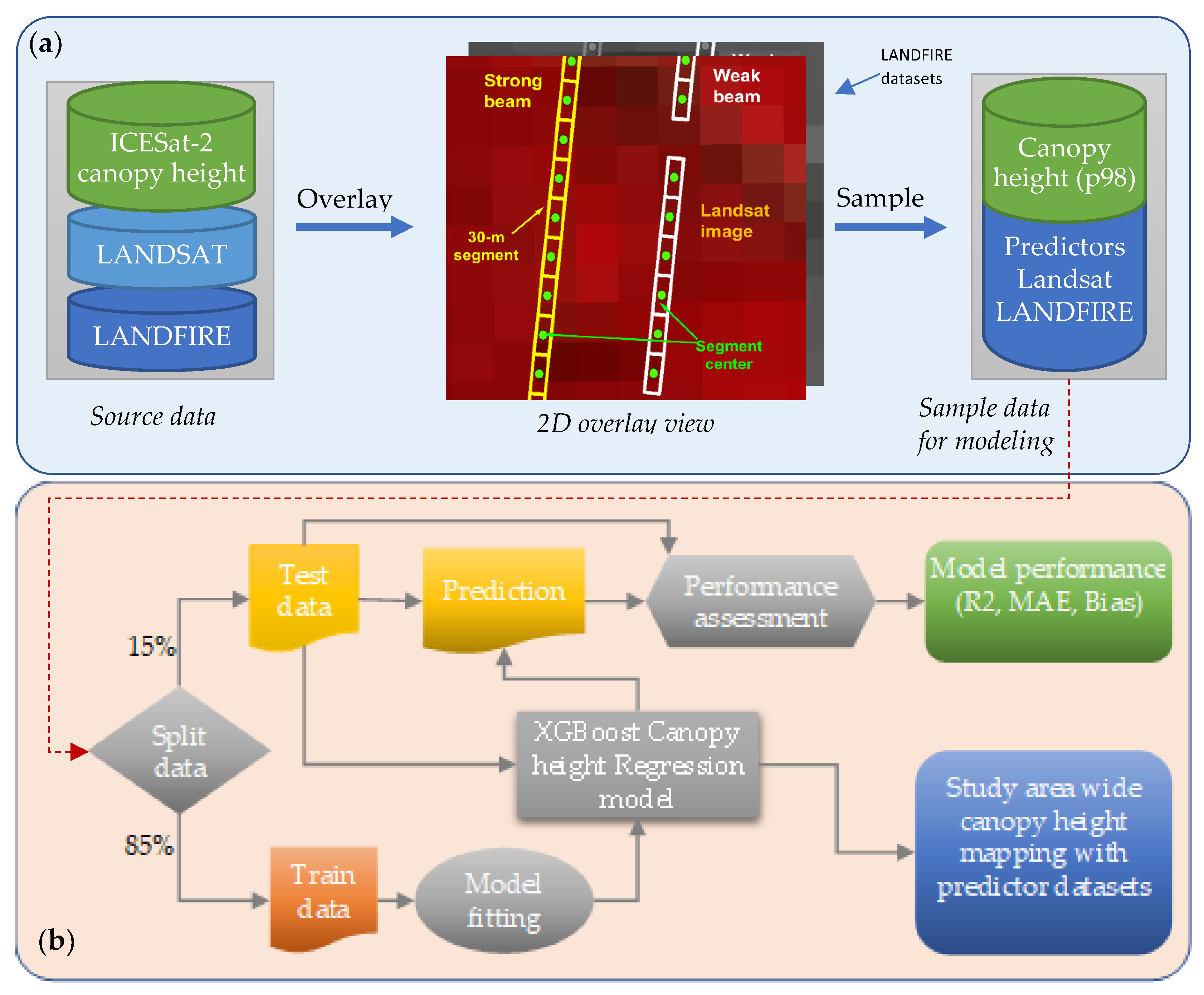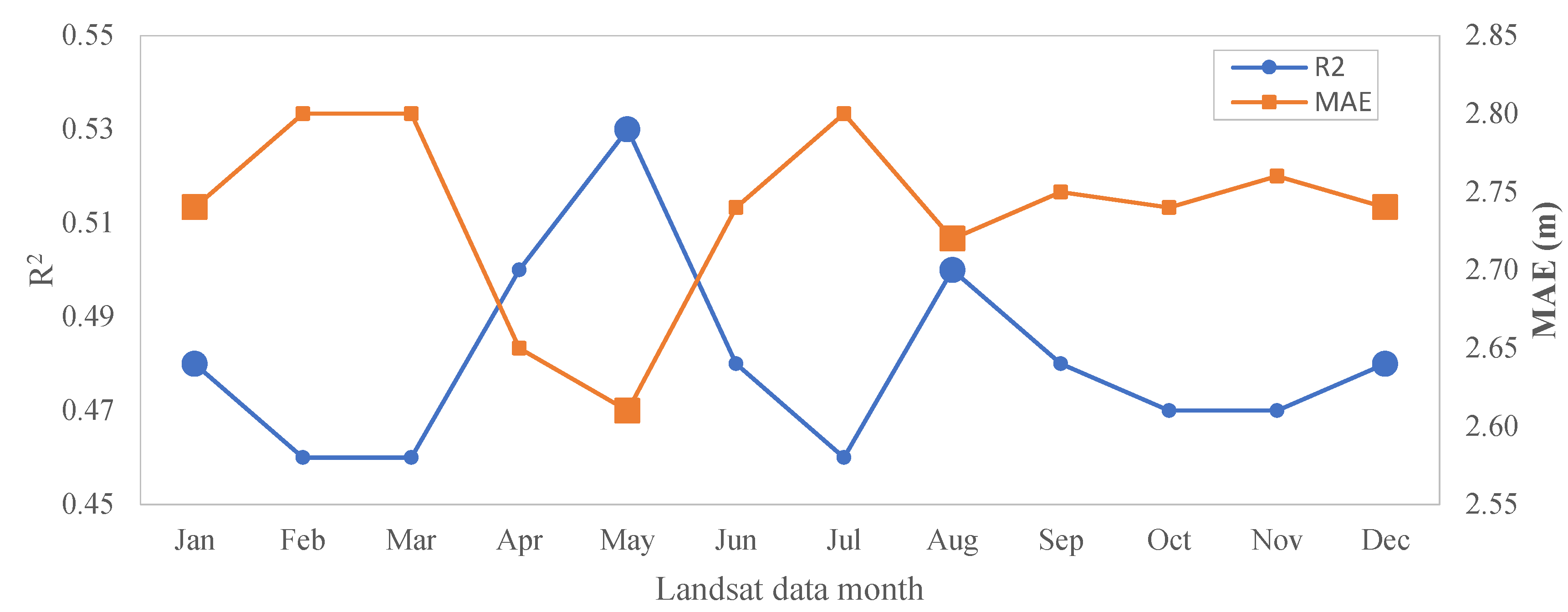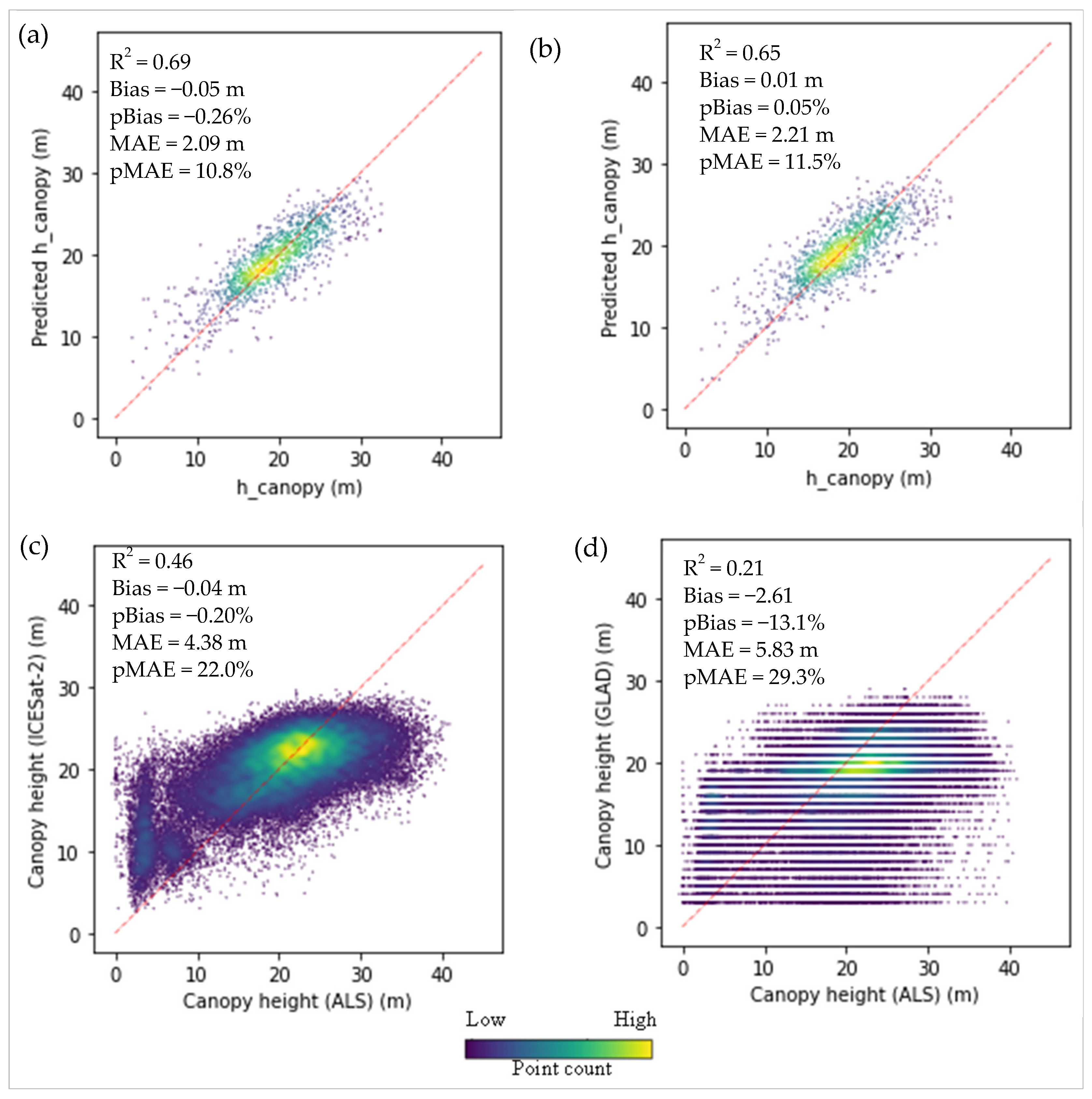Landsat-Scale Regional Forest Canopy Height Mapping Using ICESat-2 Along-Track Heights: Case Study of Eastern Texas
Abstract
1. Introduction
2. Materials and Methods
2.1. Study Area
2.2. ICESat-2 Data
2.3. Ancillary and Accuracy Assessment Data
- Gap-filled Landsat data. Landsat data are promising predictors given the sensitivity of spectral radiation in different wavelengths to changes in forest structure [11,26]. Given the high prevalence of cloud cover in the study area which made obtaining cloud-free Landsat scenes across the entire area difficult, we applied gap-filled Landsat data. Gap-filled data are produced by imputation of missing image values due to cloud cover and sensor-specific problems such as Landsat’s scan line corrector (SLC) error [27]. The gap-filling method proposed by Moreno et al. (2020) fuses multispectral Landsat (5–8) and MODIS to produce monthly gap-free high resolution (30 m) observations over the contiguous United States. Quantitative evaluations of the generated products showed highly correlated (R2 > 0.85) and precise (relative mean error below 1.5%) estimates against reference data [25], which we found suitable for canopy height modeling.
- LANDFIRE datasets: LANDFIRE datasets applied in this study capture physical forest structure characteristics such as average vegetation height, forest canopy height, and fuel-related variables such as canopy bulk density at the Landsat scale, providing a promising set of prior estimates of canopy height and forest structure characteristics. Table 1 provides a listing and brief descriptions of the datasets included.
- Land cover disturbance data: We also mapped land cover disturbances to account for the impact of land cover changes on our modeling, using the LandTrendr algorithm [15]. LandTrendr applies a spectral–temporal segmentation algorithm to characterize land surface changes such as deforestation or forest recovery from a Landsat time series providing the start and end time of a change event, the change magnitude, and duration. Changes were mapped from 2010 to 2021 based on annual Landsat composites. To facilitate filtering of changed pixels prior to modeling, the year of disturbance output from LandTrendr was recoded into a binary pixel-based layer: 1, for areas that changed since the lidar acquisition in 2016, and 0, for all unchanged areas.
- Airborne lidar data: For validating our canopy height estimates, we obtained existing airborne lidar data in selected areas across our study area (Figure 1). Sample data were collected over the study site from OpenTopography (https://opentopography.org/ (accessed on 27 July 2022)), a web portal that facilitates open sharing and access to a wide variety of airborne lidar data worldwide. The data was acquired between 2016 and 2017 under the 3D Elevation Program (3DEP), which is providing the data through OpenTopography [28]. The ready-classified airborne lidar data had an average point density of 9.44 pts per square meter, georeferenced to NAD83(2011), UTM zone 15N reference frame.
- Global Land Analysis and Discovery (GLAD) GEDI Global Forest Canopy Height, 2019: We also investigated the GLAD product [11] to compare our product with similar existing products. Global Forest Canopy Height is generated with a 30-m spatial resolution through fusion of GEDI canopy heights (95th percentile relative height) and multitemporal Landsat analysis-ready data [11].
2.4. Data Processing
2.4.1. Selecting Sample ICESat-2 Data Granules
2.4.2. Retrieving Classified Photon Data
2.4.3. ICESat-2 Canopy Height Calculation
2.4.4. Data Filtering and Sampling
2.5. Canopy Height Regression Modeling
2.5.1. Model Fitting and Evaluation
- Separate models built using LANDFIRE data and each monthly Landsat image from January to December 2020.
- A combined model built by combining all the Landsat 8 and LANDFIRE data to assess the benefit of using all the multitemporal Landsat data.
- Reduced model built using LANDFIRE data and Landsat data from the four best performing months to assess if we could achieve a compromise between model performance and data volume.
2.5.2. Scaling Along-Track Canopy Heights to a Regional Gridded Map
3. Results
3.1. Canopy Height Regression Model Performance
3.2. Gridded Canopy Height Product and Assessment
4. Discussion
5. Conclusions
Author Contributions
Funding
Data Availability Statement
Conflicts of Interest
Appendix A
| Per-Month Landsat Variables | LANDFIRE | ||||||||||||
|---|---|---|---|---|---|---|---|---|---|---|---|---|---|
| Jan | Feb | Mar | Apr | May | Jun | Jul | Aug | Sep | Oct | Nov | Dec | ||
| R2 | 0.43 | 0.39 | 0.26 | 0.36 | 0.43 | 0.37 | 0.32 | 0.39 | 0.34 | 0.42 | 0.39 | 0.42 | 0.48 |
| Bias (m) | −0.01 | −0.05 | 0.01 | 0.04 | −0.01 | −0.04 | 0 | 0.01 | −0.08 | −0.04 | 0.05 | 0.01 | −0.05 |
| pBias (%) | −0.06 | −0.21 | 0.05 | 0.16 | −0.02 | −0.17 | 0.02 | 0.05 | −0.35 | −0.21 | 0.25 | 0.04 | −0.21 |
| MAE (m) | 3.55 | 3.71 | 4.09 | 3.74 | 3.51 | 3.74 | 3.93 | 3.7 | 3.89 | 3.62 | 3.71 | 3.61 | 3.37 |
| pMAE (%) | 16.54 | 17.27 | 19.06 | 17.4 | 16.35 | 17.41 | 18.27 | 17.24 | 18.11 | 16.85 | 17.28 | 16.83 | 15.67 |
References
- Schimel, D.; Pavlick, R.; Fisher, J.B.; Asner, G.P.; Saatchi, S.; Townsend, P.; Miller, C.; Frankenberg, C.; Hibbard, K.; Cox, P. Observing terrestrial ecosystems and the carbon cycle from space. Glob. Chang. Biol. 2015, 21, 1762–1776. [Google Scholar] [CrossRef] [PubMed]
- Radtke, P.; Walker, D.; Frank, J.; Weiskittel, A.; DeYoung, C.; MacFarlane, D.; Domke, G.; Woodall, C.; Coulston, J.; Westfall, J. Improved accuracy of aboveground biomass and carbon estimates for live trees in forests of the eastern united states. For. Int. J. For. Res. 2017, 90, 32–46. [Google Scholar] [CrossRef]
- Nelson, R.; Valenti, M.A.; Short, A.; Keller, C. A multiple resource inventory of delaware using airborne laser data. Bioscience 2003, 53, 981–992. [Google Scholar] [CrossRef]
- Wulder, M.A.; White, J.C.; Nelson, R.F.; Næsset, E.; Ørka, H.O.; Coops, N.C.; Hilker, T.; Bater, C.W.; Gobakken, T. Lidar sampling for large-area forest characterization: A review. Remote Sens. Environ. 2012, 121, 196–209. [Google Scholar] [CrossRef]
- Malambo, L.; Popescu, S.C. Assessing the agreement of icesat-2 terrain and canopy height with airborne lidar over us ecozones. Remote Sens. Environ. 2021, 266, 112711. [Google Scholar] [CrossRef]
- Markus, T.; Neumann, T.; Martino, A.; Abdalati, W.; Brunt, K.; Csatho, B.; Farrell, S.; Fricker, H.; Gardner, A.; Harding, D.; et al. The ice, cloud, and land elevation satellite-2 (icesat-2): Science requirements, concept, and implementation. Remote Sens. Environ. 2017, 190, 260–273. [Google Scholar] [CrossRef]
- Magruder, L.A.; Brunt, K.M.; Alonzo, M. Early icesat-2 on-orbit geolocation validation using ground-based corner cube retro-reflectors. Remote Sens. 2020, 12, 3653. [Google Scholar] [CrossRef]
- Neumann, T.; Brenner, A.; Hancock, D.; Robbins, J.; Saba, J.; Harbeck, K.; Gibbons, A. Ice, Cloud, and Land Elevation Satellite–2 (Icesat-2) Project: Algorithm Theoretical Basis Document (Atbd) for Global Geolocated Photons (atl03); National Aeronautics and Space Administration, Goddard Space Flight Center: Greenbelt, MD, USA, 2019.
- Popescu, S.C.; Zhou, T.; Nelson, R.; Neuenschwander, A.; Sheridan, R.; Narine, L.; Walsh, K.M. Photon counting lidar: An adaptive ground and canopy height retrieval algorithm for icesat-2 data. Remote Sens. Environ. 2018, 208, 154–170. [Google Scholar] [CrossRef]
- Liu, X.; Su, Y.; Hu, T.; Yang, Q.; Liu, B.; Deng, Y.; Tang, H.; Tang, Z.; Fang, J.; Guo, Q. Neural network guided interpolation for mapping canopy height of China’s forests by integrating gedi and icesat-2 data. Remote Sens. Environ. 2022, 269, 112844. [Google Scholar] [CrossRef]
- Potapov, P.; Li, X.; Hernandez-Serna, A.; Tyukavina, A.; Hansen, M.C.; Kommareddy, A.; Pickens, A.; Turubanova, S.; Tang, H.; Silva, C.E.; et al. Mapping global forest canopy height through integration of gedi and landsat data. Remote Sens. Environ. 2021, 253, 112165. [Google Scholar] [CrossRef]
- Simard, M.; Pinto, N.; Fisher, J.B.; Baccini, A. Mapping forest canopy height globally with spaceborne lidar. J. Geophys. Res. Biogeosci. 2011, 116, G04021. [Google Scholar] [CrossRef]
- Ghamisi, P.; Rasti, B.; Yokoya, N.; Wang, Q.; Hofle, B.; Bruzzone, L.; Bovolo, F.; Chi, M.; Anders, K.; Gloaguen, R. Multisource and multitemporal data fusion in remote sensing: A comprehensive review of the state of the art. IEEE Geosci. Remote Sens. Mag. 2019, 7, 6–39. [Google Scholar] [CrossRef]
- Lunetta, R.S.; Johnson, D.M.; Lyon, J.G.; Crotwell, J. Impacts of imagery temporal frequency on land-cover change detection monitoring. Remote Sens. Environ. 2004, 89, 444–454. [Google Scholar] [CrossRef]
- Kennedy, R.E.; Yang, Z.; Gorelick, N.; Braaten, J.; Cavalcante, L.; Cohen, W.B.; Healey, S. Implementation of the landtrendr algorithm on google earth engine. Remote Sens. 2018, 10, 691. [Google Scholar] [CrossRef]
- Montesano, P.; Rosette, J.; Sun, G.; North, P.; Nelson, R.; Dubayah, R.; Ranson, K.; Kharuk, V. The uncertainty of biomass estimates from modeled icesat-2 returns across a boreal forest gradient. Remote Sens. Environ. 2015, 158, 95–109. [Google Scholar] [CrossRef]
- Liu, M.; Popescu, S.; Malambo, L. Effects of spatial resolution on burned forest classification with icesat-2 photon counting data. Front. Remote Sens. 2021, 17, 666251. [Google Scholar] [CrossRef]
- Malambo, L.; Popescu, S.C.; Murray, S.C.; Putman, E.; Pugh, N.A.; Horne, D.W.; Richardson, G.; Sheridan, R.; Rooney, W.L.; Avant, R.; et al. Multitemporal field-based plant height estimation using 3d point clouds generated from small unmanned aerial systems high-resolution imagery. Int. J. Appl. Earth Obs. Geoinf. 2018, 64, 31–42. [Google Scholar] [CrossRef]
- Vogelmann, J.E.; Xian, G.; Homer, C.; Tolk, B. Monitoring gradual ecosystem change using landsat time series analyses: Case studies in selected forest and rangeland ecosystems. Remote Sens. Environ. 2012, 122, 92–105. [Google Scholar] [CrossRef]
- Rollins, M.G. Landfire: A nationally consistent vegetation, wildland fire, and fuel assessment. Int. J. Wildland Fire 2009, 18, 235–249. [Google Scholar] [CrossRef]
- Elliott, L. Descriptions of Systems, Mapping Subsystems, and Vegetation Types for Texas. In Texas Parks and Wildlife Ecological Systems Classification and Mapping Project; Texas Parks & Wildlife Department: Austin, TX, USA, 2014. [Google Scholar]
- Dinerstein, E.; Olson, D.; Joshi, A.; Vynne, C.; Burgess, N.D.; Wikramanayake, E.; Hahn, N.; Palminteri, S.; Hedao, P.; Noss, R.; et al. An ecoregion-based approach to protecting half the terrestrial realm. Bioscience 2017, 67, 534–545. [Google Scholar] [CrossRef]
- Neuenschwander, A.; Pitts, K. The atl08 land and vegetation product for the icesat-2 mission. Remote Sens. Environ. 2019, 221, 247–259. [Google Scholar] [CrossRef]
- Malambo, L.; Popescu, S. Photonlabeler: An inter-disciplinary platform for visual interpretation and labeling of icesat-2 geolocated photon data. Remote Sens. 2020, 12, 3168. [Google Scholar] [CrossRef]
- Moreno-Martínez, Á.; Izquierdo-Verdiguier, E.; Maneta, M.P.; Camps-Valls, G.; Robinson, N.; Muñoz-Marí, J.; Sedano, F.; Clinton, N.; Running, S.W. Multispectral high resolution sensor fusion for smoothing and gap-filling in the cloud. Remote Sens. Environ. 2020, 247, 111901. [Google Scholar] [CrossRef] [PubMed]
- Malambo, L.; Heatwole, C.D. Automated training sample definition for seasonal burned area mapping. ISPRS J. Photogramm. Remote Sens. 2020, 160, 107–123. [Google Scholar] [CrossRef]
- Malambo, L.; Heatwole, C.D. A multitemporal profile-based interpolation method for gap filling nonstationary data. IEEE Trans. Geosci. Remote Sens. 2015, 54, 252–261. [Google Scholar] [CrossRef]
- Thatcher, C.A.; Lukas, V.; Stoker, J.M. The 3D Elevation Program and Energy for the Nation; US Geological Survey: Reston, VA, USA, 2020; pp. 2327–6932. [Google Scholar]
- Neuenschwander, A.; Pitts, K.; Jelley, B.; Robbins, J.; Klotz, B.; Popescu, S.; Nelson, R.; Harding, D.; Pederson, D.; Sheridan, R. Atlas/Icesat-2 l3a Land and Vegetation Height, Version 5; NSIDC: National Snow and Ice Data Center: Boulder, CO, USA, 2021. [Google Scholar]
- Neuenschwander, A.; Guenther, E.; White, J.C.; Duncanson, L.; Montesano, P. Validation of icesat-2 terrain and canopy heights in boreal forests. Remote Sens. Environ. 2020, 251, 112110. [Google Scholar] [CrossRef]
- Chen, T.; He, T.; Benesty, M.; Khotilovich, V.; Tang, Y.; Cho, H. Xgboost: Extreme gradient boosting. R Package Version 0.4-2 2015, 1, 1–4. [Google Scholar]
- Breiman, L. Random forests. Mach. Learn. 2001, 45, 5–32. [Google Scholar] [CrossRef]
- Lundberg, S.M.; Lee, S.-I. A unified approach to interpreting model predictions. Adv. Neural Inf. Process. Syst. 2017, 30, 4768–4777. [Google Scholar]
- Wijaya, A.; Kusnadi, S.; Gloaguen, R.; Heilmeier, H. Improved strategy for estimating stem volume and forest biomass using moderate resolution remote sensing data and gis. J. For. Res. 2010, 21, 1–12. [Google Scholar] [CrossRef]
- Lefsky, M.A. A global forest canopy height map from the moderate resolution imaging spectroradiometer and the geoscience laser altimeter system. Geophys. Res. Lett. 2010, 37. [Google Scholar] [CrossRef]
- Blackard, J.; Finco, M.; Helmer, E.; Holden, G.; Hoppus, M.; Jacobs, D.; Lister, A.; Moisen, G.; Nelson, M.; Riemann, R. Mapping us forest biomass using nationwide forest inventory data and moderate resolution information. Remote Sens. Environ. 2008, 112, 1658–1677. [Google Scholar] [CrossRef]
- Huang, C.; Coward, S.N.; Masek, J.G.; Thomas, N.; Zhu, Z.; Vogelmann, J.E. An automated approach for reconstructing recent forest disturbance history using dense landsat time series stacks. Remote Sens. Environ. 2010, 114, 183–198. [Google Scholar] [CrossRef]
- Horn, F.; Pack, R.; Rieger, M. The Autofeat Python Library for Automated Feature Engineering and Selection. In Joint European Conference on Machine Learning and Knowledge Discovery in Databases, 2019; Springer: Berlin/Heidelberg, Germany, 2019; pp. 111–120. [Google Scholar]
- Silva, C.A.; Duncanson, L.; Hancock, S.; Neuenschwander, A.; Thomas, N.; Hofton, M.; Fatoyinbo, L.; Simard, M.; Marshak, C.Z.; Armston, J. Fusing simulated gedi, icesat-2 and nisar data for regional aboveground biomass mapping. Remote Sens. Environ. 2021, 253, 112234. [Google Scholar] [CrossRef]







| Dataset | Description and Purpose |
|---|---|
| 2020 Monthly Gap-filled Landsat data | 2020 Monthly gap-filled Landsat data produced by fusing Landsat and MODIS multispectral images [25]. Source: Google Earth Engine (https://code.earthengine.google.com/?asset=projects/KalmanGFwork/GFLandsat_V1 (accessed on 20 August 2022)). |
| 2020 LANDFIRE Existing Vegetation Height (EVH) | The average height of the dominant vegetation for a 30-m grid cell. |
| 2020 LANDFIRE Forest Canopy Height (CH) | The average height of the top of the vegetated canopy a 30-m grid cell. Estimated in forested areas only. |
| 2020 LANDFIRE Forest Canopy Base Height (CBH) | The average height from the ground to a forest stand’s canopy bottom. |
| 2020 LANDFIRE Forest Canopy Cover (CC) | Percent tree cover, estimated in forested areas only. Values range from 15 to 95% in 10% steps. Non-forest assigned value 0. |
| 2020 LANDFIRE Forest Canopy Bulk Density (CBD) | The density of available canopy fuel in a stand, estimated in forested areas only. For ancillary forest structure information. |
| 2020 LANDFIRE Existing Vegetation Type (EVT) | Represents mapped current distribution of the terrestrial ecological systems classification. |
| Land cover disturbance 2016–2021 | Binary land cover change layer indicating areas that changed from 2016 as mapped by LandTrendr algorithms. Processing script adapted from: https://emapr.github.io/LT-GEE/example-scripts.html (accessed on 20 August 2022) |
| Airborne lidar data (2016–2018) | Source of canopy height validation data. Refer to Figure 1 for spatial distribution of the data collected. |
| Global Land Analysis and Discovery (GLAD) GEDI Global Forest Canopy Height, 2019 | Existing canopy height dataset for comparative assessment with our generated product. Data is available at the GLAD website (https://glad.umd.edu/dataset/gedi/ (accessed on 16 October 2022)) or through a Google Earth Engine Application (https://glad.earthengine.app/view/global-forest-canopy-height-2019 (accessed on 16 October 2022)). |
| Jan | Feb | Mar | Apr | May | Jun | Jul | Aug | Sep | Oct | Nov | Dec | Best4 | All | |
|---|---|---|---|---|---|---|---|---|---|---|---|---|---|---|
| R2 | 0.48 | 0.46 | 0.46 | 0.50 | 0.53 | 0.48 | 0.46 | 0.50 | 0.48 | 0.47 | 0.47 | 0.48 | 0.65 | 0.69 |
| Bias (m) | 0.04 | 0.03 | 0.05 | 0.08 | 0.01 | 0.06 | 0.10 | 0.05 | 0.00 | 0.05 | 0.06 | 0.05 | 0.01 | −0.05 |
| pBias (%) | 0.23 | 0.16 | 0.25 | 0.44 | 0.05 | 0.30 | 0.50 | 0.28 | −0.01 | 0.25 | 0.30 | 0.28 | 0.05 | −0.26 |
| MAE (m) | 2.74 | 2.80 | 2.80 | 2.65 | 2.61 | 2.74 | 2.80 | 2.72 | 2.75 | 2.74 | 2.76 | 2.74 | 2.21 | 2.09 |
| pMAE (%) | 14.2 | 14.5 | 14.5 | 13.7 | 13.5 | 14.2 | 14.5 | 14.1 | 14.2 | 14.2 | 14.3 | 14.2 | 11.5 | 10.8 |
Disclaimer/Publisher’s Note: The statements, opinions and data contained in all publications are solely those of the individual author(s) and contributor(s) and not of MDPI and/or the editor(s). MDPI and/or the editor(s) disclaim responsibility for any injury to people or property resulting from any ideas, methods, instructions or products referred to in the content. |
© 2022 by the authors. Licensee MDPI, Basel, Switzerland. This article is an open access article distributed under the terms and conditions of the Creative Commons Attribution (CC BY) license (https://creativecommons.org/licenses/by/4.0/).
Share and Cite
Malambo, L.; Popescu, S.; Liu, M. Landsat-Scale Regional Forest Canopy Height Mapping Using ICESat-2 Along-Track Heights: Case Study of Eastern Texas. Remote Sens. 2023, 15, 1. https://doi.org/10.3390/rs15010001
Malambo L, Popescu S, Liu M. Landsat-Scale Regional Forest Canopy Height Mapping Using ICESat-2 Along-Track Heights: Case Study of Eastern Texas. Remote Sensing. 2023; 15(1):1. https://doi.org/10.3390/rs15010001
Chicago/Turabian StyleMalambo, Lonesome, Sorin Popescu, and Meng Liu. 2023. "Landsat-Scale Regional Forest Canopy Height Mapping Using ICESat-2 Along-Track Heights: Case Study of Eastern Texas" Remote Sensing 15, no. 1: 1. https://doi.org/10.3390/rs15010001
APA StyleMalambo, L., Popescu, S., & Liu, M. (2023). Landsat-Scale Regional Forest Canopy Height Mapping Using ICESat-2 Along-Track Heights: Case Study of Eastern Texas. Remote Sensing, 15(1), 1. https://doi.org/10.3390/rs15010001








